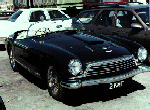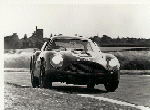The story of the DB series goes back to 1939. Claude Hill, Aston's chief-
engineer thought about applying Citroën's unibody construction and
mix it with the C-type's specifications. The result was the Atom with
independent front suspension, unibody and Cotal pre-selection gearbox. It
was the star of the 1940 London Motor Show, but the War intervened.
After the war Aston struggled with financial difficulties. It was a relief
that David Brown bought the company. He bought Lagonda as well. With Lagonda
came the W.O. Bentley-developed 2.6 liter 6-cylinder and Frank Feley, a great
designer. In 1948 the first DB (named after David Brown), the DB1 was shown.
It was a development of the Atom. A stripped down version won the 1948 24-hour
Spa race. Only 15 were made of this car.
The DB2 debuted in 1950 with the 2.6 105 bhp engine, taken over from Lagonda
and the Aston chassis.
The Vantage differed from the base model that it had a more powerful engine:
125 bhp.
The DB2 featured independent trailing link
suspension and in the debut year it took equal first index of Performance at
Le Mans and won the 3-litre class. The 3-litre engine was introduced as
standard in all models shortly after the introduction of the DB2-4, which
had two occasional rear seats.
|

Aston Martin DB2 Vantage

Aston Martin DB2 drophead.
|

|
Concurrent with the DB2 came the racing DB3, designed by Eberan von Eberhorst.
This man is famous for the Auto Union racers of the '40s. This racer was
succeeded by the DB3S of which 30 were made between 1953 and 1956. It was
one of the most succesful (if not THE most) Aston racer.
|
Meanwhile, in late 1953, the DB2 had grown into the DB2/4 with more legroom
at the rear, more luggage space and an extended roof.
 Aston Martin DB 2/4 coupé
Aston Martin DB 2/4 coupé
As usual drophead version were offered as well.
 Aston Martin DB 2/4 Mk II Spider from 1956
Aston Martin DB 2/4 Mk II Spider from 1956
The photos were taken by
Dave Sisson. He saw the extremely rare DB 2/4 Spider
in a parking lot and thought "it's lookin' great:.
This car (with the same registration number) has been mentioned in the
April 1995 issue of Classic and Sportscar as
"... was one of just three
Spiders ordered from Touring by David Brown, and marked the beginning of a
rewarding association between Aston and the famous Milan coachbuilder. All
survive, two in American and this ... the only rhd example, which is still in
England".
The DB4 was introduced in 1958 at the London Motor Show. This car was on
a completely different chassis concept from its predecessors, being the
platform chassis as opposed to the space frame of previous post-war models.
A variation of the platform chassis was also used on the Lagonda Rapide,
which was produced between 1960 and 1963.
 Aston Martin DB4 GT Sanction I by Zagato
1960 Aston Martin DB4 GT Sanction I by Zagato
1960
 same car with Jim CLark at Goodwood, 1961.
Provided by Julien Gothard. same car with Jim CLark at Goodwood, 1961.
Provided by Julien Gothard.
|
In 1959 Aston Martin developed the DB4 GT as a short wheelbase racing
version
of the DB4 saloon. Both the saloon and GT versions had handsome bodies
designed by Touring. Aston Martin wanted a series of DB4 GT's that would be
lighter and more competetive racing against the Ferrari 250 GT's, so in 1960
it contracted
Zagato to build bodies for 19 chassis. Many consider the resulting DB4 GT
Zagato to be the most attractive Zagato body ever.
|
The rounded rear end bore a strong resemblance to the contemporary
short wheelbase 250 GTs that Ferrari was then campaigning. The front was a
graceful solution to the problem of incorporating the large Aston grille
while at the same time providing good aerodynamic penetration. As a whole
the car seems both elegant and brutish. All 19 still exist in the hands of
enthusiast owners.
The DB4 GT Zagatos were marginally faster than their normal GT
stablemates, but they were no match for the Ferraris on the track, especially
the 250 GTOs.
A quarter century after the last GT Zagato was built, Victor Gauntlett and
Peter LIvanos, at the time joint chairmen at Aston Martin, took the unusual
step of having Zagato build four additional cars, assigning them the four
unused serial numbers of the 23 originally allocated in 1959 for the Zagato-
bodied series. Fourd DB4 chassis were shortened and modified to DB4 GT speci-
fications by Richard Williams, an Aston Martin specialist and owner of an
original DB4 GT Zagato... These recreations, referred to as the DB4 GT Zagato
Sanction II cars, were sold in 1991 for approximately three times the value
of a pristine original Touring-boded DB4 GT, which indicates the attraction
of the Zagato version.
Text partly taken from Automobile Quarterly (I don't know the exact issue)
The DB5 was somehow skipped, so please check:
www.astonmartindb5.com, for DB5 classifieds
or www.gbclassiccars.co.uk/aston_martin_db5.html for a bit of history.
The DB6 was introduced in 1965 as an interim model until such time as the
Company could introduce a totally new model, but the demand exceeded all
expectations and after the DBS and the DBS V8 had been introduced, there
was still a customer demand for this car until production was finished in
early 1971. During the production run of the DB6, the convertible version
was known as Volante and this was the first European car to be manufactured
with a power-operated hood.
The DB6 was available with the 6-cylinder 4-litre engine
Air conditioning, power
steering and a more advanced automatic 'box were options.
As with the DB5, the DB6 enjoyed a large enough power increase in common
Vantage trim (now worth 325bhp breathing through triple Webers) to overcome
its extra weight.
1755 DB6 were produced between October 1965 and
November 1970


Photos courtesy of Bolko Rawicz
Additional info:
- Years built: 1965-71
- Number built: 1330 MkI, 245 MkII, 1575 Total
- Built at: Newport Pagnell, Buckinghamshire, England
- Styling: Touring of Milan, Italy.
- Technical:
- 4 litre six-cylinder engine
- fabricated steel platform-type chassis
- lightweight bodyshell of Turing-patented Superleggera
construction
- ZF 5-speed manual transmission
- weight of around 1400-1500 kg (based on DB5's 1397 kg weight)
- top speed of over 220 km/h
- power of over 250 bhp
With the '70s entering two things happened: the DB series was finished,
Mr. Brown sold the company
© April 1995-1997.
Pal Negyesi



 Aston Martin DB 2/4 coupé
Aston Martin DB 2/4 coupé Aston Martin DB 2/4 Mk II Spider from 1956
Aston Martin DB 2/4 Mk II Spider from 1956
 Aston Martin DB4 GT Sanction I by Zagato
1960
Aston Martin DB4 GT Sanction I by Zagato
1960
 same car with Jim CLark at Goodwood, 1961.
Provided by Julien Gothard.
same car with Jim CLark at Goodwood, 1961.
Provided by Julien Gothard.